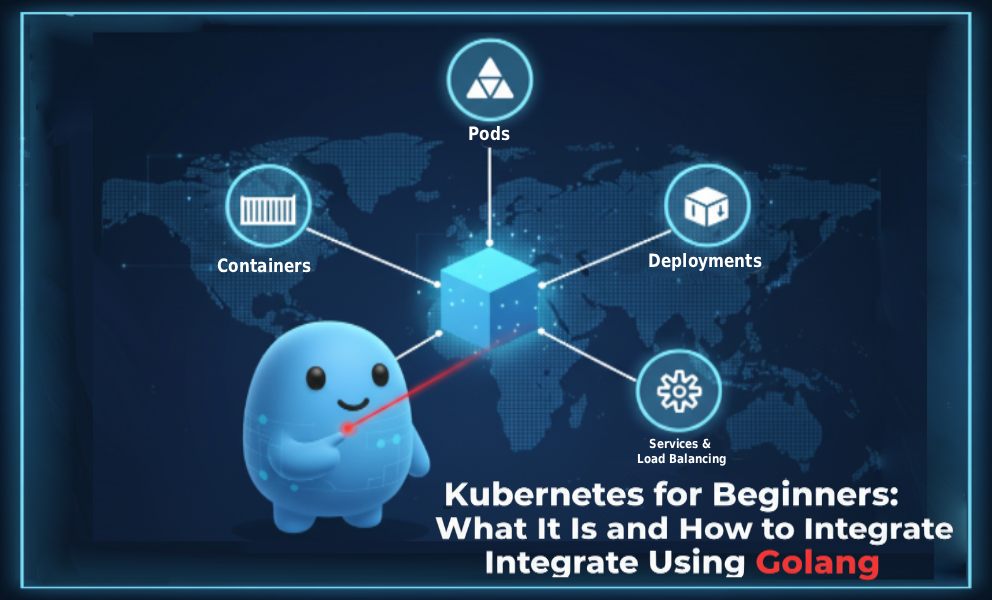Kubernetes for Beginners: Integrating with Golang
Kubernetes has become the de facto standard for container orchestration, but if you’re new, it can seem overwhelming. In this blog, we’ll break down what Kubernetes is, explain its key components with examples, and show you how to integrate Kubernetes programmatically using Golang.
What is Kubernetes?
Kubernetes (K8s) is an open-source platform for automating deployment, scaling, and management of containerized applications. Think of it as a manager for your containers, ensuring that applications always run, can handle traffic, and scale automatically.
Why Kubernetes?
- Self-Healing: If a container fails, Kubernetes restarts it automatically.
- Scaling: Automatically scales applications up or down based on load.
- Load Balancing: Distributes traffic evenly across multiple instances.
- Portability: Works on any cloud or on-premises environment.
- Automation: Allows you to define the desired state of applications and resources.
Key Kubernetes Components (Explained Simply)
1. Containers
- A container packages an application along with its dependencies.
- Example: A Node.js app running inside a Docker container.
2. Pods
- The smallest deployable unit in Kubernetes.
- Can contain one or more containers.
- Example: A pod running a single container for a web server.
3. Deployments
- Ensures a specific number of pods are always running.
- Supports rolling updates, rollback, and scaling.
- Example: You want 3 replicas of your web app running. The Deployment ensures that 3 pods are always up.
4. Services
- Provides a stable endpoint to access your pods.
- Handles load balancing and routing traffic to pods.
- Example: Users access your web app through a Service URL like
http://myapp.local.
5. Namespaces
- Logical partitions in Kubernetes to separate resources.
- Useful for environments, e.g., dev, staging, prod.
How Kubernetes Works: A Simple Example
Imagine you have a Node.js application:
- Containerize it using Docker.
- Create a Pod to run the container.
- Use a Deployment to ensure multiple pods are always running.
- Use a Service to expose the app to the internet.
Now, no matter how many users access your app, Kubernetes will handle scaling and availability automatically.
Why Use Golang with Kubernetes?
- Kubernetes itself is written in Golang.
- The official Go client library, client-go, allows developers to programmatically interact with Kubernetes clusters.
- You can:
- List pods, deployments, and services.
- Create or delete resources.
- Automate cluster operations.
- Build operators to manage complex workflows.
Integrating Kubernetes in Golang
Here’s a practical example to connect to a Kubernetes cluster and list pods using Golang.
Step 1: Initialize Go Module
go mod init my-k8s-app
go get k8s.io/client-go@v0.27.3
go get k8s.io/apimachinery@v0.27.3Step 2: Connect and List Pods
package main
import (
"context"
"fmt"
"path/filepath"
metav1 "k8s.io/apimachinery/pkg/apis/meta/v1"
"k8s.io/client-go/kubernetes"
"k8s.io/client-go/tools/clientcmd"
)
func main() {
kubeconfig := filepath.Join(homeDir(), ".kube", "config")
config, err := clientcmd.BuildConfigFromFlags("", kubeconfig)
if err != nil {
panic(err)
}
clientset, err := kubernetes.NewForConfig(config)
if err != nil {
panic(err)
}
pods, err := clientset.CoreV1().Pods("default").List(context.TODO(), metav1.ListOptions{})
if err != nil {
panic(err)
}
fmt.Println("Pods in default namespace:")
for _, pod := range pods.Items {
fmt.Println(" -", pod.Name)
}
}
func homeDir() string {
return filepath.Dir("/root")
}Explanation
- Load kubeconfig: Connects your Go program to the Kubernetes cluster.
- Create clientset: Provides access to all Kubernetes resources.
- List pods: Retrieves pod information from the default namespace.
Step 3: Next Steps with client-go
- Create Deployments programmatically.
- Scale replicas up or down.
- Watch resources in real-time using informers.
- Build custom controllers or operators to automate tasks.
Tips for Beginners
- Start with Minikube or Kind (Kubernetes in Docker) to practice locally.
- Learn kubectl commands alongside Golang to understand resource management.
- Explore client-go examples to get familiar with automation.
- Always test your Go program in a safe namespace to avoid accidentally affecting production resources.
Conclusion
- You can automate repetitive tasks in Kubernetes.
- Build operators and controllers to extend Kubernetes functionality.
- Gain a deep understanding of cloud-native architectures.




